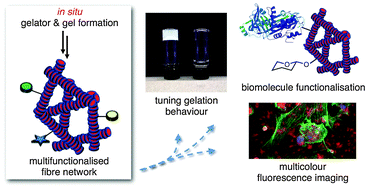A toolbox for controlling the properties and functionalisation of hydrazone-based supramolecular hydrogels†
Abstract
In recent years, we have developed a low molecular weight hydrogelator system that is formed in situ under ambient conditions through catalysed hydrazone formation between two individually non-gelating components. In this contribution, we describe a molecular toolbox based on this system which allows us to (1) investigate the limits of gel formation and fine-tuning of their bulk properties, (2) introduce multicolour fluorescent probes in an easy fashion to enable high-resolution imaging, and (3) chemically modify the supramolecular gel fibres through click and non-covalent chemistry, to expand the functionality of the resultant materials. In this paper we show preliminary applications of this toolbox, enabling covalent and non-covalent functionalisation of the gel network with proteins and multicolour imaging of hydrogel networks with embedded mammalian cells and their substructures. Overall, the results show that the toolbox allows for on demand gel network visualisation and functionalisation, enabling a wealth of applications in the areas of chemical biology and smart materials.

- This article is part of the themed collections: 2016 Journal of Materials Chemistry B Hot Papers and 2016 Journal of Materials Chemistry B Most Accessed Manuscripts

 Please wait while we load your content...
Please wait while we load your content...